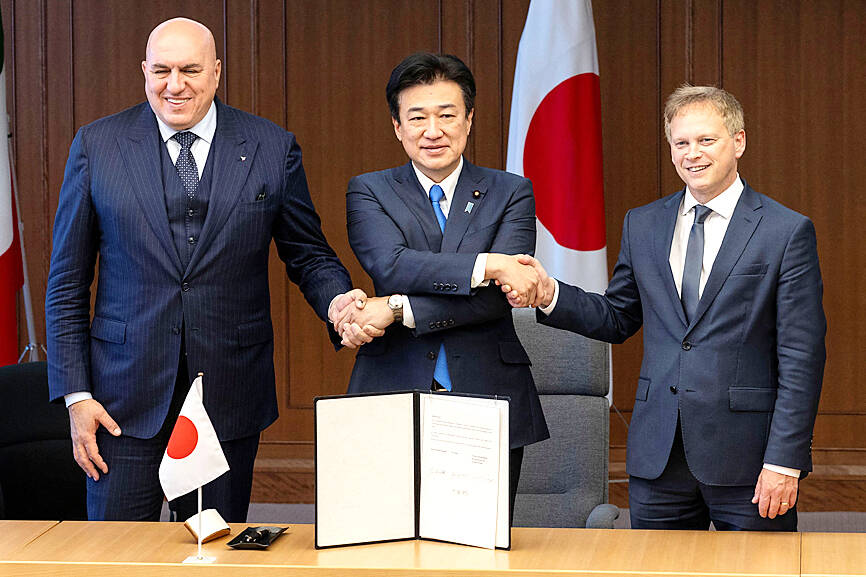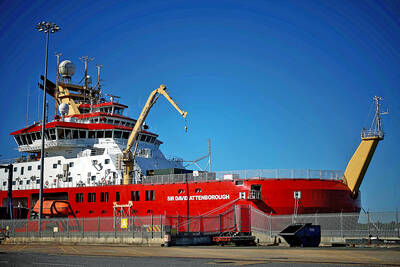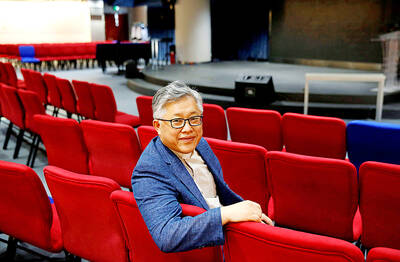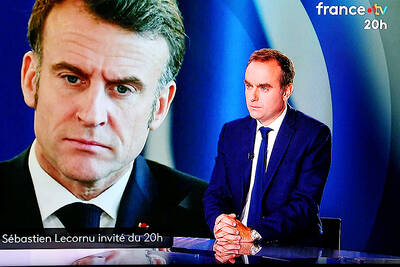Japan’s Cabinet yesterday approved a plan to sell future next-generation fighter jets that it is developing with the UK and Italy to other nations, in the latest move away from the country’s post-World War II pacifist principles.
The contentious decision to allow international arms sales is expected to help secure Japan’s role in the joint fighter jet project, and is part of a move to build up the Japanese arms industry and bolster its role in global security.
The Cabinet also endorsed a revision to Japan’s arms equipment and technology transfer guidelines to allow coproduced lethal weapons to be sold to nations other than the partners.

Photo: Reuters
Japanese Chief Cabinet Secretary Yoshimasa Hayashi said the changes are necessary given Japan’s security environment, but added that Japan’s pacifist principles remain unchanged.
“In order to achieve a fighter aircraft that meets the necessary performance and to avoid jeopardizing the defense of Japan, it is necessary to transfer finished products from Japan to countries other than partner countries,” Hayashi told reporters, adding that Tokyo would follow a strict approval process for jet sales.
“We have clearly demonstrated that we will continue to adhere to our basic philosophy as a peaceful nation,” he said.
Japan has long restricted arms exports under the pacifist constitution, but has rapidly taken steps to deregulate amid rising regional and global tensions, especially from nearby China.
The decision on jets would allow Japan to export lethal weapons it coproduces to other nations for the first time.
Japan is working with Italy and the UK to develop an advanced fighter jet to replace its aging fleet of US-designed F-2 jets, and the Eurofighter Typhoons used by the British and Italian militaries.
Japan, which was previously working on a homegrown design to be called the F-X, agreed in December 2022 to merge its effort with a British-Italian program called the Tempest for deployment in 2035. The joint project, known as the Global Combat Air Program (GCAP), is based in the UK.
Japan hopes the new plane would offer advanced capabilities Japan needs amid growing tensions in the region, giving it a technological edge against regional rivals China and Russia.
Following its wartime past as an aggressor and the devastation that followed its defeat in World War II, Japan adopted a constitution that limits its military to self-defense. The nation long maintained a strict policy to limit transfers of military equipment and technology, and ban all exports of lethal weapons.
Opponents have criticized Japanese Prime Minister Fumio Kishida’s government for committing to the fighter jet project without providing an explanation to the public or seeking approval for the major policy change.
To address such concerns, the government is limiting exports of codeveloped lethal weapons to the jet for now, and has promised that no sales would be made for use in active wars.
The government also assured that the revised guideline for the time being only applies to the jet and that it would require Cabinet approval to do so. Potential purchasers would also be limited to the 15 nations with which Japan has signed defense partnership and equipment transfer deals.
Recent polls suggest that public opinion is divided on the plan.
Japan in 2014 began to export some nonlethal military supplies, and in a latest move in December last year it approved a change that would allow sales of 80 lethal weapons and components that it manufactures under licenses from other nations back to the licensors. The change cleared the way for Japan to sell US-designed Patriot missiles to the US, helping replace munitions that Washington is sending to Ukraine.
In its decision, the Cabinet said that the arms export ban on finished products would hinder efforts to develop the new jet and limit Japan to a supporting role in the project. Italy and the UK are eager to make sales of the jet to defray development and manufacturing costs.
Kishida sought Cabinet approval before signing the GCAP agreement last month, but it was delayed by resistance from his junior coalition partner, the Buddhist-backed Komeito party.
The change also comes as Kishida is planning a state visit to Washington next month, where he is expected to stress Japan’s readiness to take on a greater role in military and defense industry partnerships.
Exports would also help boost Japan’s defense industry, which historically has catered only to the Japan Self-Defense Forces, as Kishida seeks to build up the military. Despite its effort over the past decade, the industry has still struggled to draw customers.

STEPPING UP: Diminished US polar science presence mean opportunities for the UK and other countries, although China or Russia might also fill that gap, a researcher said The UK’s flagship polar research vessel is to head to Antarctica next week to help advance dozens of climate change-linked science projects, as Western nations spearhead studies there while the US withdraws. The RRS Sir David Attenborough, a state-of-the-art ship named after the renowned British naturalist, would aid research on everything from “hunting underwater tsunamis” to tracking glacier melt and whale populations. Operated by the British Antarctic Survey (BAS), the country’s polar research institute, the 15,000-tonne icebreaker — boasting a helipad, and various laboratories and gadgetry — is pivotal to the UK’s efforts to assess climate change’s impact there. “The saying goes

Floods on Sunday trapped people in vehicles and homes in Spain as torrential rain drenched the northeastern Catalonia region, a day after downpours unleashed travel chaos on the Mediterranean island of Ibiza. Local media shared videos of roaring torrents of brown water tearing through streets and submerging vehicles. National weather agency AEMET decreed the highest red alert in the province of Tarragona, warning of 180mm of rain in 12 hours in the Ebro River delta. Catalan fire service spokesman Oriol Corbella told reporters people had been caught by surprise, with people trapped “inside vehicles, in buildings, on ground floors.” Santa Barbara Mayor Josep Lluis

Police in China detained dozens of pastors of one of its largest underground churches over the weekend, a church spokesperson and relatives said, in the biggest crackdown on Christians since 2018. The detentions, which come amid renewed China-US tensions after Beijing dramatically expanded rare earth export controls last week, drew condemnation from US Secretary of State Marco Rubio, who on Sunday called for the immediate release of the pastors. Pastor Jin Mingri (金明日), founder of Zion Church, an unofficial “house church” not sanctioned by the Chinese government, was detained at his home in the southern city of Beihai on Friday evening, said

TICKING CLOCK: A path to a budget agreement was still possible, the president’s office said, as a debate on reversing an increase of the pension age carries on French President Emmanuel Macron yesterday was racing to find a new prime minister within a two-day deadline after the resignation of outgoing French Prime Minister Sebastien Lecornu tipped the country deeper into political crisis. The presidency late on Wednesday said that Macron would name a new prime minister within 48 hours, indicating that the appointment would come by this evening at the latest. Lecornu told French television in an interview that he expected a new prime minister to be named — rather than early legislative elections or Macron’s resignation — to resolve the crisis. The developments were the latest twists in three tumultuous